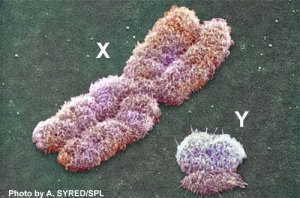The short answer is the Y-chromosome.
This short chunk of DNA contains all the genes that distinguish males from females. It is passed from father to son without mixing with the female X-chromosome.
Because it is only passed from father to son, you can track your paternal lineage back to Adam, the most recent common ancestor of all living humans today (similar to Eve, the maternal ancestor).
Adam is the base of the male family tree but there are now 21 known Y-haplotypes or branches of the family tree that were made as the descendants of Adam colonised the world.
The Y-chromosome comes in handy during paternity tests, as a son will have an identical Y-chromosome to his father; if the Y-chromosomes don’t match they can’t be related.
It’s a wee bit more difficult to determine if daughters are biologically related to a male, as females have two X-chromosomes. DNA testing techniques such as, PCR and RFLP, are used in these cases.
PCR is method that produces lots of copies of a certain stretch of DNA sequence. This can then be treated with enzymes that chop the DNA at specific sites generating different lengths of DNA (RFLP). When you compare the chopped up DNA from child and possible parent, the lengths of DNA will be virtually identical if biologically related.
As with everything in science, you can never prove anything 100% but with these DNA testing techniques you can say the probability of parentage is 99.99% if the parent is biologically related to the child.



I like the pictures, nice balance between amount of text and pictures to focus on